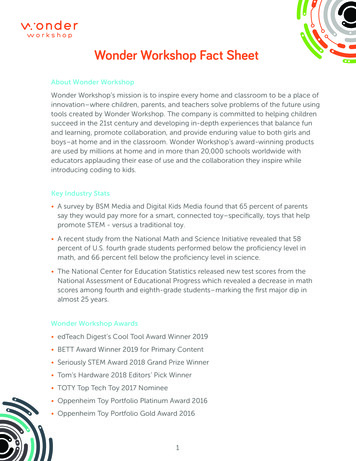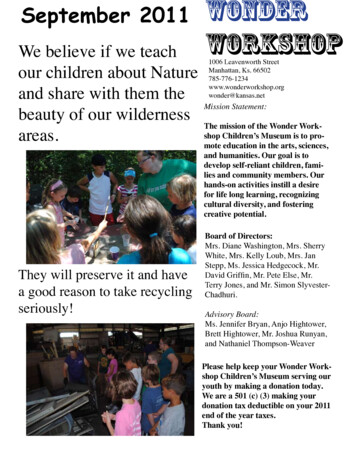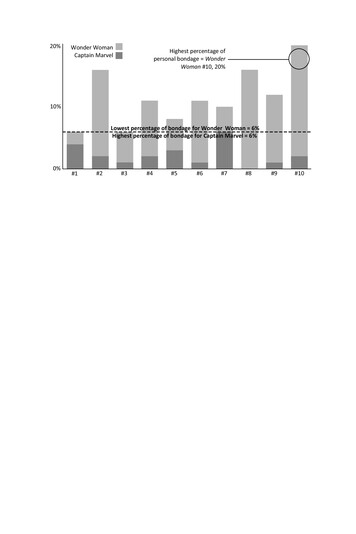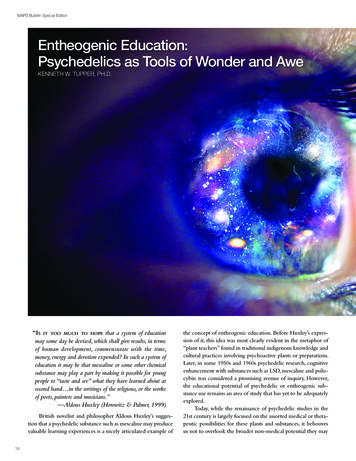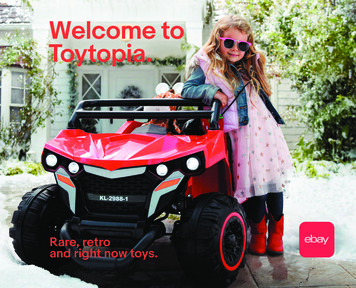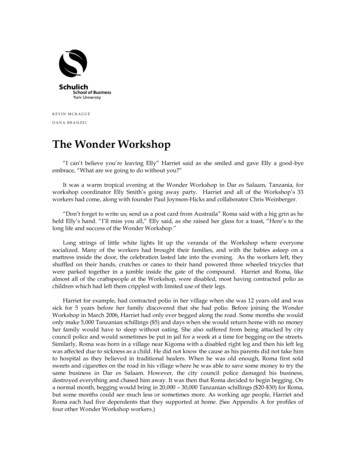
Transcription
KEVIN MCKAGUEOANA BRANZEIThe Wonder Workshop“I can’t believe you’re leaving Elly” Harriet said as she smiled and gave Elly a good-byeembrace, “What are we going to do without you?”It was a warm tropical evening at the Wonder Workshop in Dar es Salaam, Tanzania, forworkshop coordinator Elly Smith’s going away party. Harriet and all of the Workshop’s 33workers had come, along with founder Paul Joynson-Hicks and collaborator Chris Weinberger.“Don’t forget to write us; send us a post card from Austraila” Roma said with a big grin as heheld Elly’s hand. “I’ll miss you all,” Elly said, as she raised her glass for a toast, “Here’s to thelong life and success of the Wonder Workshop.”Long strings of little white lights lit up the veranda of the Workshop where everyonesocialized. Many of the workers had brought their families, and with the babies asleep on amattress inside the door, the celebration lasted late into the evening. As the workers left, theyshuffled on their hands, crutches or canes to their hand powered three wheeled tricycles thatwere parked together in a jumble inside the gate of the compound. Harriet and Roma, likealmost all of the craftspeople at the Workshop, were disabled, most having contracted polio aschildren which had left them crippled with limited use of their legs.Harriet for example, had contracted polio in her village when she was 12 years old and wassick for 5 years before her family discovered that she had polio. Before joining the WonderWorkshop in March 2006, Harriet had only ever begged along the road. Some months she wouldonly make 5,000 Tanzanian schillings ( 5) and days when she would return home with no moneyher family would have to sleep without eating. She also suffered from being attacked by citycouncil police and would sometimes be put in jail for a week at a time for begging on the streets.Similarly, Roma was born in a village near Kigoma with a disabled right leg and then his left legwas affected due to sickness as a child. He did not know the cause as his parents did not take himto hospital as they believed in traditional healers. When he was old enough, Roma first soldsweets and cigarettes on the road in his village where he was able to save some money to try thesame business in Dar es Salaam. However, the city council police damaged his business,destroyed everything and chased him away. It was then that Roma decided to begin begging. Ona normal month, begging would bring in 20,000 – 30,000 Tanzanian schillings ( 20- 30) for Roma,but some months could see much less or sometimes more. As working age people, Harriet andRoma each had five dependents that they supported at home. (See Appendix A for profiles offour other Wonder Workshop workers.)
The Wonder WorkshopWonder WeldersThe idea for the Wonder Workshop had come from Paul Joynson-Hicks, a professionalphotographer from England who had lived and worked in East Africa for many years. 1 Paul’sBlue Mango Photography Studio was in his comfortable house on the Masaki Peninsula wherethe majority of expatriates and wealthy Tanzanians lived. Paul also had some background incharitable fundraising, having organized a football club for street kids in Uganda and an annualCharity Goat Races fundraising event in Tanzania.2On a regular basis, Paul drove by the junction of Haile Selassie Road and Ali Hassan MwinyiStreet on his way to and from his studio. It was at this junction that handicapped people gatheredto ask for money from people stopped at the light. Paul had gotten to know many of the peoplethere as he chatted and bantered with them on a regular basis. Some of the people, Paul knew,enjoyed the freedom from the demands of a job if they could make enough money to get by onand didn’t have dependents to support at home. Others were there only as a last resort and werein need of some help and direction.One day in early 2004, Paul - bored with doing his accounting - went out to the back of hisworkshop and welded up a giraffe out of bolts and an ashtray out of an old tap. They were muchappreciated as presents and Paul got to thinking that perhaps the some of the people at the trafficlights could weld art objects which could be sold in Dar es Salaam and provide a self-sustainableincome. So Paul called in three of the beggars that he knew well - Michael, Ernest and Bahati who were extremely keen to try it out. So with 1,000 donated by the Charity Goat Racescommittee, Paul bought a welder, metal cutter, grinder and safety equipment and paid for themonth-long training of the three men in making welded art objects and animals from scrap metal.The Wonder Workshop was born (initially as the Wonder Welders) and founded on the mission“To provide a self-sustainable income for handicapped men and women through creating art objects,employing handicapped people who are begging, improving self-esteem and mainstreaming handicappedpeople into society in a positive way.”In the beginning, items were sold through Paul’s friends and contacts at his studio cumworkshop and some were carried by a shop in Dar es Salaam. The three (and soon seven) menthat Paul trained in welding were able to earn an income of 50 per month as an allowance fromPaul that was mostly paid for by sales from the sculptures and animals, which sold for between8,000 – 150,000 Tanzanian schillings (US 10- 50) each.Paul’s idea was being well received by the workers and new customers so Paul askedmetalworking artist Heather Cumming to come to the Wonder Workshop to work with thewelders on artistic designs.3 Heather accepted, and in January, 2005, Heather traveled to theWorkshop from her home in Scotland and stayed for two months to work with the welders.Heather taught them to make elegant artistic animals and other sculptures out of scrap metal (seeappendix B for illustrative examples of Wonder Welders designs and products that Heatherinfluenced). She also taught the welders how to look at pieces of scrap metal creatively todetermine which animal would be best suited for it. Heather, Paul and the welders workedtoward a big launch exhibition for the Wonder Welders which was held on March 11, 2005. Onthe day, over two hundred people came and the workers sold everything, raising over 4,000.2
The Wonder WorkshopElly Joins the WorkshopIt was at this time, February 2005, that Elly had joined the Wonder Workshop. Elly hadarrived in Tanzania at the end of January from Uganda with her husband who worked as a taxconsultant and had been transferred.Elly had trained as a textile designer in university in the UK. After graduation, she hadbackpacked around the world where she met her husband Harry. Together they traveled toIndia, where Elly worked with a fabric company and then back to the UK where she worked for afair trade textile company. When Harry got a job in Uganda, Elly went with him and started apaper project using recycled fibers. When Harry transferred to Tanzania, Elly quickly learnedabout the Workshop and contacted Paul. Paul showed Elly around the Workshop just as theywere busy preparing for the March 11 launch. Heather Cumming was about to return to Scotlandand with the workshop growing he offered Elly the job as coordinator of the new Workshop.Elly quickly began work, investing the cash from the launch into training more handicappedwelders and continuing to grow the Workshop. At this time the Workshop’s average turnoverwas 2,000 per month and the shop employed seven welders. With a full-time coordinator onboard, word continued to spread around Dar es Salaam and beyond about the quality work anddesigns of the Welders. Orders from shops increased and commissions started coming in.Under Elly’s leadership the Workshop moved from Paul’s backyard into its own permanentworkshop on May 1st, 2005, and was officially registered as a Tanzanian non-governmentalorganization in August of that year. The Workshop was organized into a cooperative whereeveryone associated with the workshop – the welders, Paul and Elly - were employee-members.Elly began instituting regular monthly meetings of all the workers to resolve problems and planfor the future.Paper and SoapWith an additional 3,000 donated from the 2005 Charity Goat Races, Elly wasted no time inestablishing paper-making from recycled materials as a second workshop activity. Elly hadstarted a paper making project in Uganda and Elly’s background in design helped ensure thenew product line was well received. Her artistic background also contributed to the marketing ofthe welded products as well. By the end of 2005 the Wonder Workshop had grown to employing11 employee-workers and was bringing in about 4,000 per month in sales. The next year, 2006,Elly introduced all-natural soap made from Tanzanian oils and spices to the Wonder Workshopportfolio.Wooden ToysIt was this year that saw Christopher Weinberger, a volunteer from the US, train five disabledmen how to make handmade wooden toys from renewable Tanzanian wood sources, and bringthem into the Wonder Workshop cooperative. Chris had been in Tanzania as a volunteer and hadbeen working with Nico, a local carpenter, on making beautiful hand-made wooden toys in hisgarage for fun. A carpenter himself, Chris knew that many valuable tropical hardwoods grew inTanzania, but he was concerned over sometimes illegal clear-cutting and the shipping of theunprocessed wood overseas for processing, leaving little local value added or valuable forests forfuture generations. Chris wanted to train local carpenters to make the toys so they could earn aliving as many gifted woodworkers were giving up their trade to become taxi drivers. Together,3
The Wonder WorkshopChris and Elly decided to add the wooden toys to the Wonder Workshop portfolio and were ableto secure some money from a UK trust fund to buy the machinery and woodworking toolsnecessary to launch production. It was then that Chris and Nico worked to train five additionaldisabled former-beggars in making the wooden children’s toys using off-cuts and sustainablyharvested Tanzanian hardwood.GlassElly continued expanding the Workshop in early 2007 when she established glass makingfrom recycled coloured glass containers as a new line of enterprise. Four Wonder Workshopworkers were trained by Ghanaian glass bead makers who were visiting Tanzania. 4 The workersthen returned and set up bead making at the Wonder Workshop.The Business ModelWith the expansion of the workshop beyond welding to include paper, wooden toys, soapand glass beads, Elly had taken the Workshop from an informal group of welders in the backyardof Paul’s photography studio to a team of 33 artisans trained in five different product lines, andgenerating annual sales of 80,000 (for an organigram, see Appendix C).“Hip Recycled Art” was now the Wonder Workshop tag line, and all of their products weremade of recycled materials or otherwise sustainably sourced. There was a truckload of scrapmetal of all sizes and shapes donated from Toyota; paper products were made from recyclednewsprint and banana leaf fibers grown locally; the glass jewelry was made from melted bottles,the soap and candles from natural Tanzanian oils and spices, and the wooden toys from scraps orsustainable grown wood. All of the materials were sourced locally in Tanzania.A key to the success of the Wonder Workshop had been its focus on quality artistic design inall of its product lines. All of the ex-pat workers and volunteers have were designers or artistsincluding Elly, Chris (wood), Heather (Metal), and Paul who primarily works in photography.With only a handful of notable exceptions, the local mass production of Tanzanian touristsouvenirs was uninspiring, with thousands of the same carved giraffes and painted savannahscenes being produced for the market. With so much design and artistic guidance, the trainedcraftspeople at the Workshop produced unique, interesting works of art which was in significantdemand and could demand a price premium from tourists, the ex-pat community and at themajor annual craft fairs.At the Wonder Workshop, all of the craftspeople receive a monthly salary of between 60- 75plus a 10 monthly transportation allowance. Three able-bodied foremen – Saidi Omari whomanaged the welders, Nico Ngalawa who managed the wood shop and Mariana Mahinya whomanaged the paper workshop – each earn about 170 per month including transport allowance.Elly as Workshop Manager earns 500 per month. Each employee has one month of paidholidays a year and 2 sick days per month.In addition to their base salary, the Wonder Workshop instituted a bonus incentive systembased on 5% the selling price for items when they are sold (or with a wholesale customer, afterpayment has been received). The bonus also applies to the foremen and is about 16 monthly forthe wood workers (bonus equally shared between them) and 20 for the paper workers (alsoequally shared). The welders make their bonuses individually based on the specific pieces the4
The Wonder Workshopindividual has made and these range from between 10 and 60 per month. Bonuses are added tothe worker’s base salary and are paid monthly.From the beginning, the Wonder Workshop benefited from word of mouth and many saleswere made from the office Workshop by people coming by. The 4,000 per month in sales thatthe Wonder Workshop was making at the time of Elly’s departure was broken down roughly asfollows: 25% directly from the Workshop20% to shops outside Dar es Salaam in Zanzibar, Arusha and Moshi15% from twice-yearly craft fairs in Dar es Salaam and Nairobi15% on custom commissions from individuals and organizations 510% from shops in Dar es Salaam (such as Wooden Keepsake, Airport, MawazoGallery, Cotton Club, Zantaani, Novel Idea, Ethnic Beads),10% from Hotels and Lodges in Dar es Salaam5% from shipping directly to international shops or individuals (in countriessuch as The Netherlands, Italy, South Africa, US and UK)Of the Workshop’s monthly expenses, approximately 65% went to salaries and benefits, 15%to manufacturing supplies, 10% to office supplies, 10% to other expenses such as transportation,security, and miscellaneous expenses (see financial statement appendix D). Currently, WonderWelders was not yet financially self-sustaining. Although they were turning over about 4,000 inan average month, Paul estimated that the Workshop would need a turnover of about 5,500 tobreak even. The shortfall was currently being made up from annual donations by the CharityGoat Races ( 1,000- 2,000), Paul’s Family Trust ( 2,000) and other small donations fromcompanies and donors. Typically, donations paid for the training and capital investment requiredto start up new product lines. Donations also helped to pay for other capital expenses. Forexample, the Rotary Club in Dublin donated 1,000 towards the motorized rickshaw and 12companies in Dar es Salaam each donated 100 each to pay for their audit.The Workshop had one vehicle that the able-boded foremen used to deliver products to thestores in Dar and pick up supplies. They were in the process of securing a smaller three-wheeledmotorized rickshaw that could be modified so that it could be driven by the disabled workers aswell.In terms of marketing, the Wonder Workshop had always benefited from word of mouthexposure through the ex-pat community looking for unique and high-quality gifts fromTanzania. They also had a web site and flyers and each product was sold with a tag which gavethe Wonder Welders story and contact details. Paul also had an extensive e-mail list that wasused to encourage people to support the Workshop with their purchases. In 2008, after a twoyear track record of audited financial statements, they applied for membership in theInternational Federation of Alternative Trade (IFAT). This will allow the Workshop to be listedon their website and will raise their profile with large fair trade purchasers such as 10,000Villages, Oxfam, and Trade Craft. This exposure should significantly increase the workshop’scontacts, sales channels and marketing reach.Challenges Moving ForwardAs the evening wound down and the workers began to leave one by one, Elly began to thinkabout the choices the Wonder Workshop would need to make going forward. As the last workers5
The Wonder Workshopmade their way home through the compound gate, Elly strolled through the various parts of theworkshop thinking back on the three years she had spent there.She reflected back on the letter that she had written to her future replacement, a VSOvolunteer that was coming in next week to take over her job as coordinator. The new volunteerwould arrive just after Elly would be leaving (Harry had been transferred back to his homecountry of Australia and Elly would go with him there) and Elly’s flight left the next day. In theletter, Elly had shared all of the opportunities that the workshop coordinator position would bepresented with including having amazing high-quality products that were in demand. She alsowrote about some of the challenges that would have to be faced. These included:Financial SustainabilityThe Wonder Workshop was able to cover most of its regular operating expenses but stillneeded infusions of donations to expand operations, launch new product lines or purchase anyadditional equipment such as welders and woodworking tools. The margins were slim howeverand the workshop recently raised 100 each from 12 companies in Dar es Salaam to pay for it’sfinancial audit. The new coordinator would need to ensure that the Workshop could becomemore financially self-sustaining so that it could continue to employ and train its disabled workersand hopefully grow to benefit more disabled people in the future.Worker FrictionsInevitably, there were many tensions bubbling under the surface among the employees,many of which had to do with money. Although the Workshop was organized as a coop and allof the profits were going to pay salaries and keep the organization running, there were a numberof tensions over perceptions about money. Tanzania was emerging from a long period ofsocialism, and it was very difficult for many of the workers to understand that the workshop wasa cooperative entrepreneurial venture and that no one else was profiting from their work besidesthemselves.There was also some dissatisfaction with the fact that many of the workers were paid more orless the same basic salary regardless of their ability or work ethic. The Wonder Workshop hadbeen founded with a mission to help handicapped people live productive lives and to help to seethem as valuable contributing members of society and all workers were paid similar salaries(plus the 5% bonus incentives). In a number of instances, those that worked harder resented thefact that people who couldn’t or didn’t work nearly as much were also paid the same. One of theWelders, Ernest, complained that “I am tired of having to be here to make money for handicappedpeople. I want to make money for myself and only myself and what’s wrong with that?” Some of theworkers saw the indented equitable design of the salaries as inequitable. The bonus schemebenefited the individual efforts of the welders who were paid per piece, but did not reward theindividual efforts of any of the other workers. And it seemed that all of the workers, whetherthey were hard working or not, was unsatisfied with the level of their salaries (which wereequivalent to the Tanzanian minimum wage) and wanted them to be significantly increased.Order Volume, Timeliness and QualityNow that they were members of the International Federation of Alternative Trade and werebecome better known locally, Elly knew that they would soon be getting larger orders from some6
The Wonder Workshopof the major Fair Trade organizations like 10,000 villages. This would be an amazing opportunityto increase their turnover. However, these large orders would need to be filled on time and witha high standard of quality. The Workshop was used to working on its own time with few outsidescheduling demands.Question of Scale and MissionElly also worried that if the project became too professional and scaled up too much that itwould lose its heart and soul and drift away from its social mission.The Way ForwardWith her bags packed, Elly walked home through the workshop gates and her flight the nextmorning. What would be the next steps for the Wonder Workshop ?7
The Wonder WorkshopAppendix A: Wonder Workshop Employee ProfilesErnest NyabalaleBorn: 1968, Kigoma kijijiniFamily: Parents still living in Kigoma.Current: Ernest lives in Dar es Salaam,Kinondoni with a younger brother whoworks as a security guard. He came to Dsm in1982 to study. He finished secondary schoolin 1991. Since then he has done variouscourse in computer studies and typing.However he has found it difficult to findwork. Ernest currently survives by help fromfriends and his brother.Medical: He was born with handicapped legs,the problem is not known.Michael FundiBorn: 1982, Dodoma.Family: Mother lives in Dodoma.Current: Michael currently lives in Dsm,Ukonga with a friend. He earns between Tsh20,000 – 25,000 per month by begging on theroadside. He came to Dsm in 1999 to do somebusiness / trading. After building a small stalland endeavouring to sell water and sweets,his stall was demolished by the City Council.This happened more than once. Since then hehas had to resort to begging to earn anymoney. He finished school at Standard Two.Medical: Michael got polio as a small child, hedoesn’t remember when.Other: He says that he would like “to work toimprove himself.”8
The Wonder WorkshopPetro ‘Bahati’ AndreaBorn: 1968, Kigoma kijijiniFamily: Bahati has three children and a wifeliving in Kigamboni.Current: He says his wife does not work and heis the main bread earner of the family. He earnsbetween Tsh 20,000 and 30,000 per month bybegging on the roadside. Bahati came to Dsm 13years ago from Mwanza, where he had work ina factory, which closed down. There was nowork available in Mwanza so he came to Dsmlooking for work. He tried a small tradingbusiness but was demolished and continuallyremoved by the City Council.Medical: Bahati went down with polio at 11years old. Within two weeks, he says, both legswere crippled. The clinic was too far to go toreceive treatment. He stayed at home.Joyce JosephJoyce Joseph suffered from Polio when she was3 years old, since then she has lived with theserious effects of this illness which left herphysically disabled and unable to walk. Withthe aid of a specially designed orthopaedicshoe, crutch and metal brace she can movearound however, this equipment is costly andher family was only able to buy her a very basicversion which does not allow her to bend herleg. Therefore she spends the majority of hertime with her leg in a permanent,uncomfortable position. The new technologycosts 375,000/ (about 150) and with it shewould be able to walk and sit in comfort andwith ease as she could bend her leg.9
The Wonder WorkshopAppendix B: Pictures of Wonder Workshop Products10
The Wonder WorkshopWonder Workshop Tent at Nairobi Craft Show11
The Wonder WorkshopAppendix C: OrganigramWonder WorkshopCooperative(33 worker-members)Manager /DesignAdvisor (Elly)WonderWelders1 Foreman11 WeldersPaperProducts1 Foreman6 den Toys1 Foreman4 craftspeopleSoap5 craftspeople1% of revenueGlass Beads5 craftspeople(start-up)Manager &DesignConsultant(Chris)15% ofrevenue30% of salesrevenue55% of salesrevenue12
The Wonder WorkshopAppendix D: Financial Statement of ActivityStatement of ActivityREVENUE & SUPPORTSalesDecember 04December 05December 06 2,129,019 4,566,994 124,576 762,758WeldingPaperWoodOther (soap, candles, glass) Donations5,593,014 242,924 6,431,844 2,913,220 6,542,252 2,574,039 2,332,266 3,199,961Manufacturing Supplies 513,011 743,671 746,994Office Expenses 259,240 285,544 398,616 685,104 (10,271)Goat RacesPaul’s eting and CommunicationsRentOther 40,000TOTAL 3,386,290 4,046,585 4,335,300 3,045,554 (1,133,365) 2,206,952INCREASE INNET ASSETS13
The Wonder WorkshopAppendix E: Wonder Workshop Timeline and MilestonesMarch 2004Paul gets the idea for Wonder Welders, driving by disabled beggars atthe corner in Dar es Salaam31st March 2004Paul writes first Wonder Welders ProposalCharity goat races donation establishes Wonder Welders and 3 disabledmen are taught to weldDecember 20048 people trained in welding and working at the workshopJan & Feb 2005Heather Cumming trains welders in new designs in scrap metal.February 2005Elly comes on board, having arrived in Tz in late JanuaryMarch 11, 2005First Exhibition of new designs. Money raised helps further expand theworkshop and train more disabled welders.May 1, 2005Workshop moves from Paul’s backyard to present homeAugust 2005Wonder Workshop officially registered as a Tanzanian NGOOctober 2005 (or is itJan 2006?)Wonder Workshop expands beyond welding as recycled paper-making isintroduced with training from Eleanor Smith and funding from theCharity Goat Races and training from Eleanor Smith.April 2006Carpentry workshop set-up by Christopher Weinberger, a volunteer fromthe US, trained 5 disabled men how to make handmade wooden toysfrom renewable Tanzanian wood sources.July 2, 2006First Exhibition of launch of wooden toys at Tanz HandsA soap-making section was started where handmade soaps are madefrom local oils and spices.November 2006Makutano sales (Arusha - 2,500)December 2006Nairobi Craft Sale( 1,400)Jan 12, 2007Sale at Belgium Embassy ( 300)Feb 2007Glass making coming on line as four workers are trained.May 2008Registered member of the International Federation of Alternative TradeJan 2008Elly’s going away party14
The Wonder WorkshopEndnotesPaul specialized in African wildlife photography and published books on Tanzania, Uganda and Zambia and freelancedfor many hotels, camps lodges and other corporate clients. See www.pauljhicks.com.12See http://www.tigersclub.org/ and http://www.goatraces.com/.3Further background on Heather Cumming and her work can be found at www.ironfairy.co.uk/about.htm.The Ghanaian beadmakers’ work in Tanzania was organized by Alex Wilson, the editor of The Bead is Constant,Published by Ghana Universities Press, 2003, on the history and culture of beads in Ghana.4For example: custom wedding invitations on their paper, welded trophies for sporting events, bookshelves for theBritish High Commission and small gifts in the shape of miners hats for a large Gold mining company.515
The Wonder Workshop was born (initially as the Wonder Welders) and founded on the mission "To provide a self-sustainable income for handicapped men and women through creating art objects, employing handicapped people who are begging, improving self-esteem and mainstreaming handicapped people into society in a positive way." .



